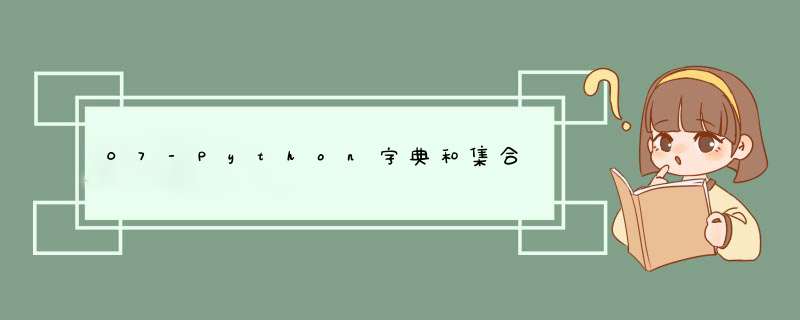
Python字典和集合
- 👨💻作者简介: 大家好,我是小火车~~
- 🛳️个人主页: 上进小火车的博客
- 📗系列专栏: 本文收藏在《Python基础从0到1》专栏
- ✉️如果文章知识点有错误的地方,请指正! 和大家一起学习一起进步🎈
- 🔥如果觉得博主的文章还不错的话,请👍三连支持👍一下博主哦
- ➡️各系列思维导图链接
- 一🥖. 字典
- 1.1 字典定义
- 1.2 字典的创建
- 1.3 字典元素的读取
- 1.4 字典元素的添加
- 1.5 字典删除
- 1.6 判断一个key是否在字典中
- 1.7 遍历字典
- 1.8 有序字典
- 1.9 字典推导式
- 二🍔. 集合
- 2.1 集合定义
- 2.2 集合的创建
- 2.3 集合的删除
- 2.4 集合元素的增加与删除
- 2.5 集合 *** 作
- 2.6 集合推导式
- 三🥧.其他专栏
一🥖. 字典 1.1 字典定义
字典(dictionary)是包含若干“键:值”元素的无序可变序列,字典中的每个元素包含“键”和“值”两部分,定义字典时,每个元素的键和值用冒号分隔,元素之间用逗号分隔,所有的元素放在一对大括号“{}”中。字典中的键可以为任意不可变数据,比如整数、实数、字符串、元组等等。
1.2 字典的创建- 使用“=”将一个字典赋值给一个变量
>>> a_dict = {'server': 'db.neuedu.com', 'database': 'mysql'}
>>> a_dict
{'database': 'mysql', 'server': 'db.neuedu.com'}
>>> x = {} #空字典
>>> x
{}
- 使用dict()利用已有数据创建字典
>>> keys = ['a', 'b', 'c', 'd']
>>> values = [1, 2, 3, 4]
>>> dictionary = dict(zip(keys, values))
>>> dictionary
{'a': 1, 'c': 3, 'b': 2, 'd': 4}
>>> x = dict() #空字典
>>> x
{}
- 使用dict()根据给定的键、值创建字典
>>> d = dict(name='Dong', age=37)
>>> d
{'age': 37, 'name': 'Dong'}
- 以给定内容为键,创建值为空的字典
>>> adict = dict.fromkeys(['name', 'age', 'sex'])
>>> adict
{'age': None, 'name': None, 'sex': None}
- 以键作为下标可以读取字典元素,若键不存在则抛出异常
>>> aDict = {'name':'Dong', 'sex':'male', 'age':37}
>>> aDict['name']
'Dong'
>>> aDict['tel'] #键不存在,抛出异常
Traceback (most recent call last):
File "" , line 1, in <module>
aDict['tel']
KeyError: 'tel'
- 使用字典对象的get方法获取指定键对应的值,并且可以在键不存在的时候返回指定值。
>>> print(aDict.get('address'))
None
>>> print(aDict.get('address', 'SDIBT'))
SDIBT
>>> aDict['score'] = aDict.get('score',[])
>>> aDict['score'].append(98)
>>> aDict['score'].append(97)
>>> aDict
{'age': 37, 'score': [98, 97], 'name': 'Dong', 'sex': 'male'}
- 使用字典对象的items()方法可以返回字典的键、值对列表
>>> aDict={'name':'Dong', 'sex':'male', 'age':37}
>>> for item in aDict.items(): #输出字典中所有元素
print(item)
('age', 37)
('name', 'Dong')
('sex', 'male')
>>> for key in aDict: #不加特殊说明,默认输出键
print(key)
age
name
sex
- 使用字典对象的keys()方法可以返回字典的键列表
>>> aDict.keys() #返回所有键
dict_keys(['name', 'sex', 'age']
- 使用字典对象的values()方法可以返回字典的值列表
>>> aDict.values() #返回所有值
dict_values(['Dong', 'male', 37])
- 使用字典对象的setdefault()方法返回指定“键”对应的“值”,如果字典中不存在该“键”,就添加一个新元素并设置该“键”对应的“值”。
>>aDict ={'name' : 'Wang','sex' : 'male'}
>>>aDict.setdefault('age','28') #增加新元素
'28'
>>>aDic
{'name' : 'Wang','sex' : 'male','age':'28'}
- 当以指定键为下标为字典赋值时,若键存在,则可以修改该键的值;若不存在,则表示添加一个键、值对。
>>> aDict['age'] = 38 #修改元素值
>>> aDict
{'age': 38, 'name': 'Dong', 'sex': 'male'}
>>> aDict['address'] = 'SDIBT' #增加新元素
>>> aDict
{'age': 38, 'address': 'SDIBT', 'name': 'Dong', 'sex': 'male'}
- 使用字典对象的update方法将另一个字典的键、值对添加到当前字典对象
>>> aDict
{'age': 37, 'score': [98, 97], 'name': 'Dong', 'sex': 'male'}
>>> aDict.items()
dict_items([('age', 37), ('score', [98, 97]), ('name', 'Dong'), ('sex', 'male')])
>>> aDict.update({'a':'a','b':'b'})
>>> aDict
{'a': 'a', 'score': [98, 97], 'name': 'Dong', 'age': 37, 'b': 'b', 'sex': 'male'}
- 使用del删除整个字典,或者字典中的指定元素
- 使用pop()和popitem()方法d出并删除指定元素
- 使用clear()方法清空字典中所有元素
字典clear()方法
clear()方法是用来清除字典中的所有数据,因为是原地 *** 作,所以返回None(也可以理解为没有返回值)
>>> x['name'] = 'lili'
>>> x['age'] = 20
>>> x
{'age': 20, 'name': 'lili'}
>>> x.clear()
>>> x
{ }
字典pop()方法
移除字典数据pop()方法的作用是:删除指定给定键所对应的值,返回这个值并从字典中把它移除。注意字典pop()方法与列表pop()方法作用完全不同。
>>> x = {'a':1,'b':2}
>>> x.pop('a')
1
>>> x
{'b': 2}
字典popitem()方法
字典popitem()方法作用是:用于d出字典中的元素,按照后进先出(LIFO)返回并删除字典中最后的一对键和值(项)。对于字典来说,里面的元素并没有顺序的概念,也没有append或类似的方法,所以这里所说的最后一个key-value对,也就是为字典添加key-value对时的顺序,最后一个添加的key-value对就是最后一个元素。在工作时如果遇到需要逐一删除项的工作,用popitem()方法效率很高。
>>> x
{'url': 'www.neuedu.com', 'title': 'python web site'}
>>> x.popitem()
('url', 'www.neuedu.com')
>>> x
{'title': 'python web site'}
使用in方法:
#生成一个字典
d = {'name':'tom', 'age':10, 'Tel':110}
#打印返回值,其中d.keys()是列出字典所有的key
print ('name' in d.keys())
print ('name' in d)
#两个的结果都是返回True
除了使用in还可以使用not in,判定这个key不存在。
1.7 遍历字典(1)遍历key值
>>> a
{'a': '1', 'b': '2', 'c': '3'}
>>> for key in a:
print(key+':'+a[key])
a:1
b:2
c:3
>>> for key in a.keys():
print(key+':'+a[key])
a:1
b:2
c:3
在使用上,for key in a和 for key in a.keys():完全等价。
(2)遍历value值
>>> for value in a.values():
print(value)
(3)遍历字典项
>>> for kv in a.items():
print(kv)
('a', '1')
('b', '2')
('c', '3')
(4)遍历字典健值
>>> for key,value in a.items():
print(key+':'+value)
a:1
b:2
c:3
>>> for (key,value) in a.items():
print(key+':'+value)
a:1
b:2
c:3
在使用上for key,value in a.items()与for (key,value) in a.items()完全等价
1.8 有序字典Python内置字典是无序的,如果需要一个可以记住元素插入顺序的字典,可以使用collections.OrderedDict。
>>> x = dict() #无序字典
>>> x['a'] = 3
>>> x['b'] = 5
>>> x['c'] = 8
>>> x
{'b': 5, 'c': 8, 'a': 3}
>>> import collections
>>> x = collections.OrderedDict() #有序字典
>>> x['a'] = 3
>>> x['b'] = 5
>>> x['c'] = 8
>>> x
OrderedDict([('a', 3), ('b', 5), ('c', 8)])
1.前言
可以对比列表推导式的思路,与字典推导式的进行对比,训练自己的学习迁移能力。
2.表达式
{ key_expr: value_expr for value in collection if condition }
3.实例
用字典推导式以字符串以及其索引位置建字典
# 代码如下:
strings = ['import','is','with','if','file','exception','liuhu']
d = {key: val for val,key in enumerate(strings)}
# 用字典推导式以字符串以及其长度位置建字典
s = {strings[i]: len(strings[i]) for i in range(len(strings))}
k = {k:len(k)for k in strings} #相比上一个写法简单很多
print(d)
# {'import': 0, 'is': 1, 'with': 2, 'if': 3, 'file': 4, 'exception': 5, 'liuhu': 6}
print(s)
# {'import': 6, 'is': 2, 'with': 4, 'if': 2, 'file': 4, 'exception': 9, 'liuhu': 5}
print(k)
# {'import': 6, 'is': 2, 'with': 4, 'if': 2, 'file': 4, 'exception': 9, 'liuhu': 5}
同一个字母但不同大小写的值合并起来了。
mc = {'a': 10, 'b': 34, 'A': 7, 'Z': 3}
mca = {k.lower(): mc.get(k.lower(), 0) + mc.get(k.upper(), 0) for k in mc.keys()}
# mcase_frequency == {'a': 17, 'z': 3, 'b': 34} she
集合是无序可变序列,使用一对大括号界定,元素不可重复,同一个集合中每个元素都是唯一的。集合中只能包含数字、字符串、元组等不可变类型的数据,而不能包含列表、字典、集合等可变类型的数据。
2.2 集合的创建直接将集合赋值给变量
>>> a = {3, 5}
>>> a.add(7) #向集合中添加元素
>>> a
{3, 5, 7}
使用set将其他类型数据转换为集合
>>> a_set = set(range(8,14))
>>> a_set
{8, 9, 10, 11, 12, 13}
>>> b_set = set([0, 1, 2, 3, 0, 1, 2, 3, 7, 8]) #自动去除重复
>>> b_set
{0, 1, 2, 3, 7, 8}
>>> c_set = set() #空集合
>>> c_set
set()
使用del删除整个集合
2.4 集合元素的增加与删除增加元素 使用add()方法为集合添加新元素,如果该元素已存在于集合中则忽略该 *** 作。
>>>s = {1,2,3}
>>>s.add(3)
>>>s
{1,2,3}
使用update()方法合并另外一个集合中的元素到当前集合中
>>>s = {1,2,3}
>>>s.update({3,4,5})
>>>s
{1,2,3,4,5}
删除元素 当不再使用某个集合时,可以使用del命令删除整个集合。集合对象的pop()方法d出并删除其中一个元素,remove()方法直接删除指定元素,clear()方法清空集合。
>>> a = {1, 4, 2, 3}
>>> a.pop()
1
>>> a.pop()
2
>>> a
{3, 4}
>>> a.add(2)
>>> a
{2, 3, 4}
>>> a.remove(3)
>>> a
{2, 4}
Python集合支持交集、并集、差集等运算 例如:
>>> a_set = set([8, 9, 10, 11, 12, 13])
>>> b_set = {0, 1, 2, 3, 7, 8}
>>> a_set | b_set #并集
{0, 1, 2, 3, 7, 8, 9, 10, 11, 12, 13}
>>> a_set.union(b_set) #并集
{0, 1, 2, 3, 7, 8, 9, 10, 11, 12, 13}
>>> a_set & b_set #交集
{8}
>>> a_set.intersection(b_set) #交集
{8}
>>> a_set.difference(b_set) #差集
{9, 10, 11, 12, 13}
>>> a_set - b_set
{9, 10, 11, 12, 13}
>>> x = {1, 2, 3}
>>> y = {1, 2, 5}
>>> z = {1, 2, 3, 4}
>>> x.issubset(y) #测试是否为子集
False
>>> x < y #比较集合大小/包含关系
False
>>> x.issubset(z)
True
>>> x < z #真子集
True
使用集合快速提取序列中单一元素
>>> import random
>>> listRandom = [random.choice(range(500)) for i in range(100)]
>>> noRepeat = []
>>> for i in listRandom :
if i not in noRepeat :
noRepeat.append(i)
>>> len(listRandom)
>>> len(noRepeat)
>>> newSet = set(listRandom)
Python也支持集合推导式。
>>> s = {x.strip() for x in (' he ', 'she ', ' I')}
>>> s
{'I', 'she', 'he'}
三🥧.其他专栏
❤️《Python基础从0到1》专栏
🧡《Python进阶从0到1》专栏
💛《Python爬虫》专栏
💚《Python数据处理》专栏
欢迎分享,转载请注明来源:内存溢出

 微信扫一扫
微信扫一扫
 支付宝扫一扫
支付宝扫一扫
评论列表(0条)